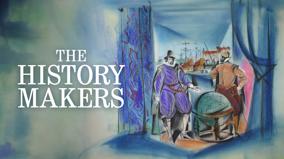George-Étienne Cartier: The Lion of Québec
This short biopic profiles Montreal lawyer-turned-politician George-Étienne Cartier as he campaigns to unite English and French Canada under Confederation. The political world of a century ago comes to life as we hear debates in the Parliament of Upper and Lower Canada amidst political strife and personal feuds. Ultimately, Cartier skilfully allays the fears of party and sectional leaders, convincing them that federal union would protect, rather than weaken, Quebec’s cherished rights of language and religion. The eloquent and enigmatic Cartier was instrumental in shaping the Canada that was soon to emerge.
-
 The History Makers1959 - 1964 3 editionsFrom the most intrepid explorers to the fathers of Confederation, this series of 17 half-hour episodes tells the compelling early history of our great country.
The History Makers1959 - 1964 3 editionsFrom the most intrepid explorers to the fathers of Confederation, this series of 17 half-hour episodes tells the compelling early history of our great country.
This short biopic profiles Montreal lawyer-turned-politician George-Étienne Cartier as he campaigns to unite English and French Canada under Confederation. The political world of a century ago comes to life as we hear debates in the Parliament of Upper and Lower Canada amidst political strife and personal feuds. Ultimately, Cartier skilfully allays the fears of party and sectional leaders, convincing them that federal union would protect, rather than weaken, Quebec’s cherished rights of language and religion. The eloquent and enigmatic Cartier was instrumental in shaping the Canada that was soon to emerge.
-
directorJohn Howe
-
producerJulian Biggs
-
executive producerGuy Glover
-
scriptCharles Cohen
-
photographyReginald Morris
-
soundJoseph ChampagneRon Alexander
-
sound editingKathleen Shannon
-
castRobert ChristiePaul HébertRoger MarshallWilliam NeedlesJohn VernonJacques AugerDenis DrouinIvor BarryAnne LauriaultLarry ZahabWalter Massey
Summarize the opposing political views held by George Brown and George Etienne Cartier. Write a newspaper report from the time period that identifies the challenges of uniting Upper and Lower Canada (ensure that the 5Ws are addressed: who, what, where, when, and why). What challenges to accepting Confederation are discussed? Focus in particular on regional concerns. Research Cartier’s contribution and involvement in the Rebellion of 1837 and later at the Charlottetown Conference (1864). In what way does Cartier seek to protect French Canada through Confederation? In the film, Cartier is presented as having two older daughters, however, in reality, only one of his daughters lived past infancy. Why might the director have taken these creative liberties?
More educational content
George-Étienne Cartier: The Lion of Québec, John Howe, provided by the National Film Board of Canada

